 |
SpeakerTalk
This forum has been set up to facilitate discussion of 1970s KEF speakers and drive units. The owner of the Forum has no connection with KEF Audio.
|
| View previous topic :: View next topic |
| Author |
Message |
Nimo_jon
Intermediate Contributor 25+

Joined: 21 Feb 2011
Posts: 48
Location: Singapore
|
 Posted: Mon Feb 21, 2011 7:46 pm Post subject: KEF 104 cross over Posted: Mon Feb 21, 2011 7:46 pm Post subject: KEF 104 cross over |
 |
|
Hello! I am new here. I am a KEF fan all my life. I am a proud owner of the KEF LS3/5a (1972), KEF 104 (1973), 104aB (1976) and the majestic 105.2 (1982).
I recently started overhauling my speakers, to revitalize them and to prevent them from rotting away. My KEF 104 is coming close to 40 years old. It is still operational.
I share my recent work on the KEF 104 crossover. The main aim was to find a cross over configuration using modern parts, to give good tonality and rich harmonics when playing chamber music, light jazz and also vocals.
The approach started from investigating the viability of changing from the original 104 to the acoustic Butterworth crossover in the 104aB. I listened to the effects of using similar values but different capacitors in the aB cross over. I later returned to the 104 original cross over, and tested with different coupling capacitors. I finally arrived at a combination that gave me the results I want.
Acoustic Butterworth
Falcon acoustics recommend the use of Alcap caps with a special Solen 0.6uF to stay faithful to the original design of the acoustic Butterworth
The common practice for most DIYer would be to rip out anything electrolytic and replace with poly propylene caps. The actual cap values were picked in factory to match the designed spec of the crossover. So using any cap from a supplier without knowing the actual spec would deviate from the intended values. There is a high chance to end up with a different sound.
This is the original 104aB crossover, showing aged capacitors. Still, the midrange of the 104aB sounded nice and smooth.
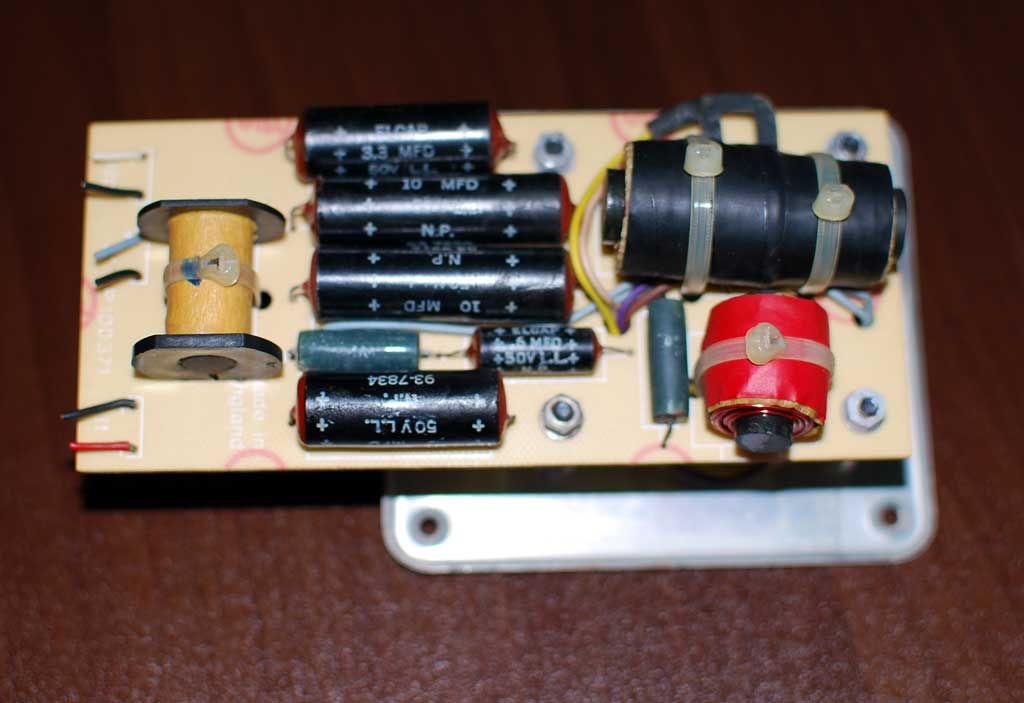
This is the aB cross over with Alcaps. I listened to this configuration, which has better sonic improvement than the Elcap. This formed a base line for me to start working on the 104.
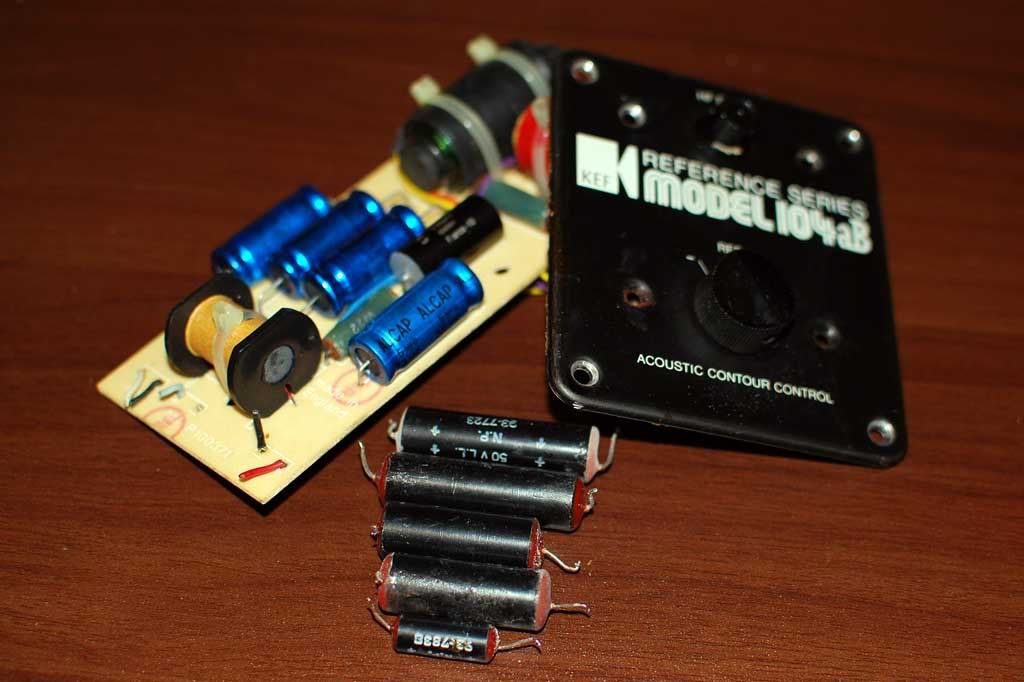
I started building the 104aB crossover onto the 104 using Alcap. This made the 104 sounded very much like the 104aB, but the rich harmonics were somewhat missing.
I later introduced the Solen in critical locations. Much to my surprise, the speaker sounded worse and worse as I added more PP caps.
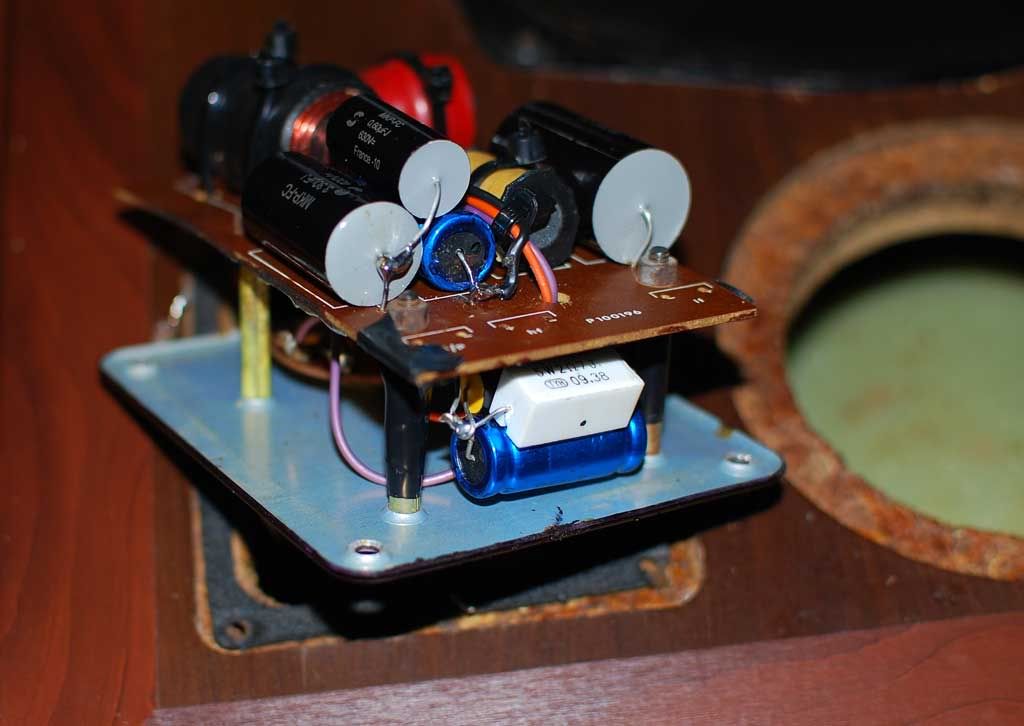
The sound was not as good as using only Alcap in the crossover. That did not make sense, but it was pretty obvious there was a certain invisible but audible veil over the speakers.
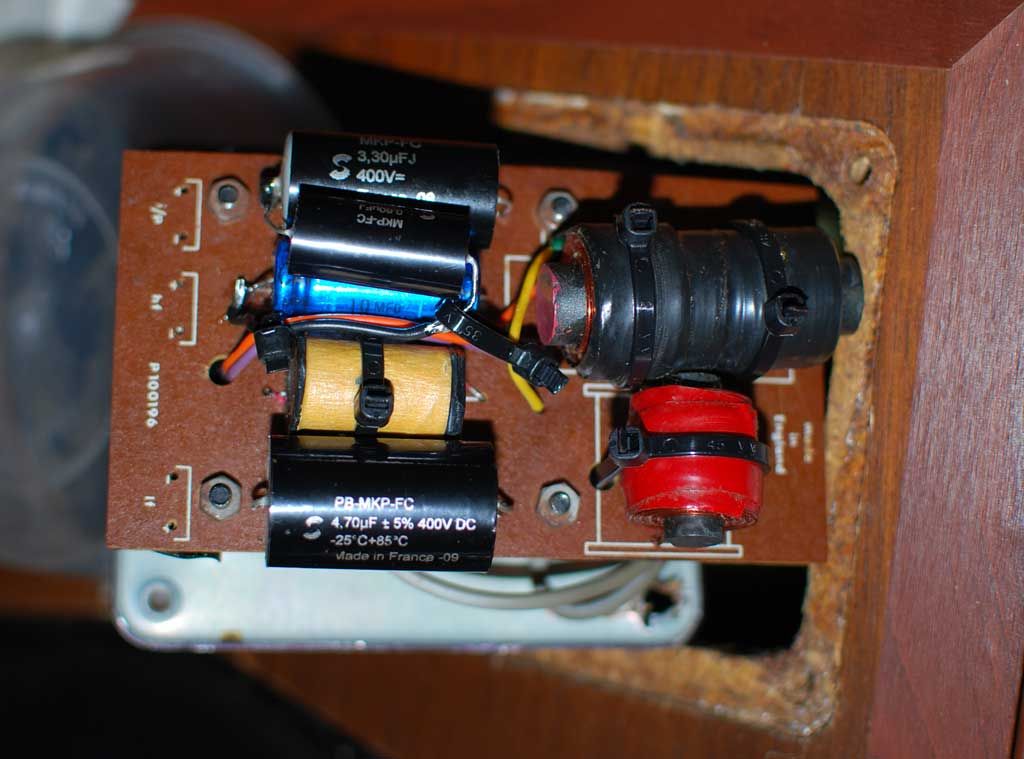
I concluded that using the Falcon aB config will be the best route to go if I want to upgrade the 104 to the 104aB. However, I felt that I lost the rich harmonics on the 104. I seldom listen to music in high levels. So the 104aB approach might not be suitable for me.
The Original 104 Crossover
The original crossover will work well for tweeters having a resonant frequency well below 1 kHz. Many modern tweeters would have resonant frequencies at about 500 Hz. However, the T27 has a resonant frequency of 1.2 kHz that may be too close to the cross over network.
The capacitors under investigation were the Alcap, Solen, the very expensive Mundorf and the Carli Mylar. Alcap and Solen are pretty common choices. The Mundorf cap was highly recommended by a friend (he has good results with other speakers using M cap, but he never tried on the 104). The Carli was recommended by an experienced and old KEF serviceman, who also has a lot of experience servicing/improving the Tangent loudspeakers.
I use the 4.2uF part location in the high pass section to test the capacitors. This 4.2uF is indeed very critical. I used Walter Wanderley’s Talking Verve (re mastered) track 2 Agua De Beber to test the crossover. The left and right tweeters each played different HF cymbals; and the Hammond organ sings away in the middle. That would make more sense than using a spectrum analyzer.
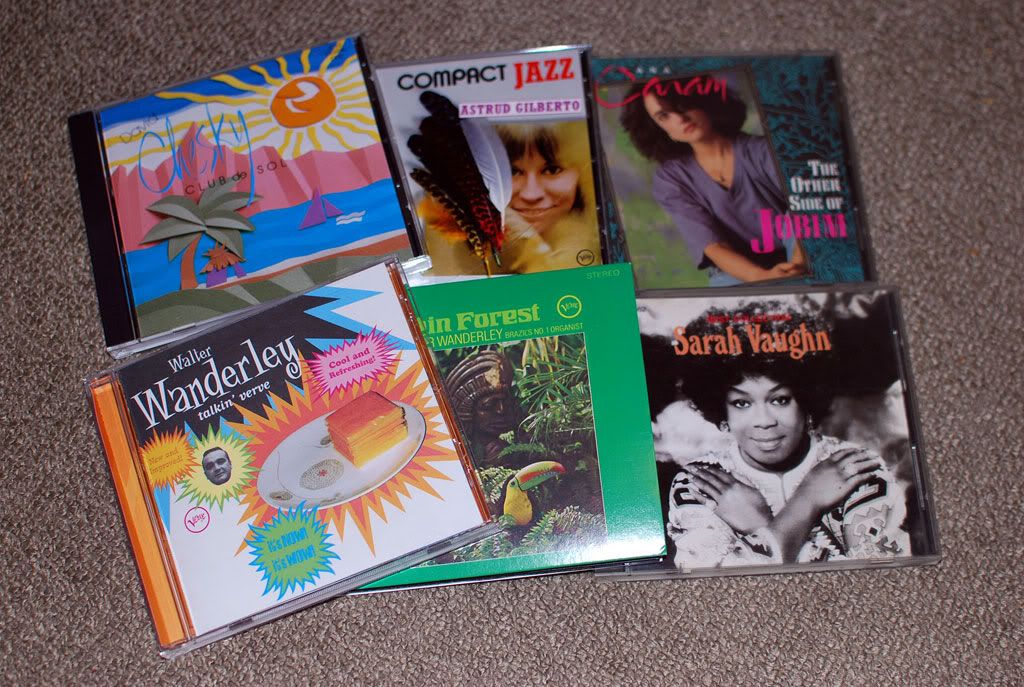
Using Alcap certainly sounded better than the old Elcaps.
Using Solen sounded lean relative to the Alcap, and more boring.
Using Mundorf sounded slightly better than the Solen, but not significantly better.
Using the Carli Mylar, oh gosh! What a difference! The band came alive!
The Carli Mylar brought out the definition of the T27. Carli has limited cap values so I used 4.7uf. I changed the rests of the caps on the cross over to Carli Mylar and repeated the above tests.
Indeed, using Solen and Mundorf did not give me the rich harmonics and tonality I was after. Using Alcap was nice for vocals but not what I really wanted for playing jazz. Carli gave the most well defined cymbals and attack, and I could hear some breaking up at loud passages.

Consulting the old technician again, he suggested I borrow the arrangements found in Tangent crossovers, that is, to use two caps in parallel instead of one single value cap.
I finally ended up with two 2.7uF Carli in parallel to form the 5uF. The cap before the inductor to ground remains as a single 4.7uF. This combination sounded smooth and have great details, nice tonality, good definition and clarity.
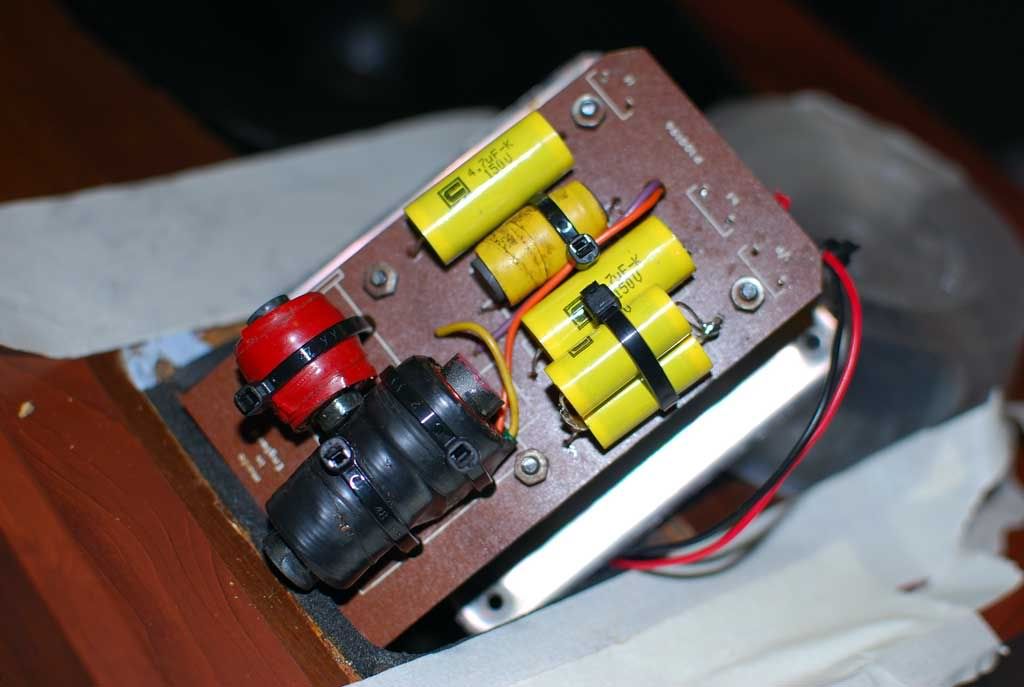
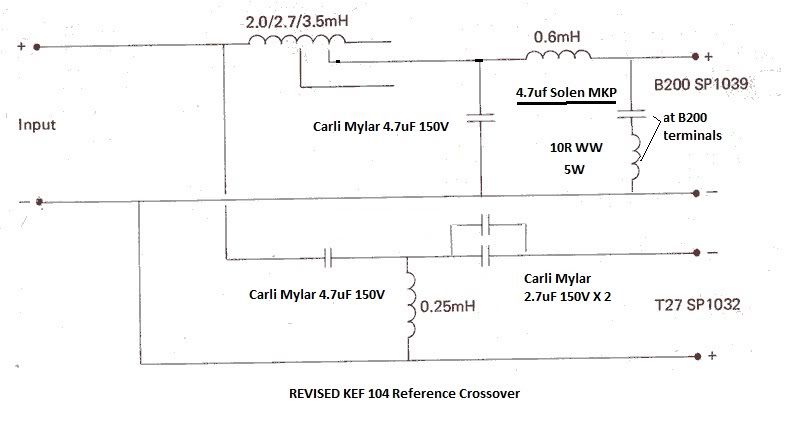
I compared this 104 cross over to the KEF 104aB. For normal to low listening level, I still find the 104 able to give more details than the 104aB. The music can be almost life like even from decent recordings. When played loud, the 104aB would remain calm but the 104 T27 may exhibit some sibilence. Initially I suspected it was the T27A on the two pairs of 104 having different characteristics. I later swapped the tweeters and confirmed the T27 were ok but it was the cross over differences I was hearing.
Due to the short wire run and the efficiency of the driver units, bi wiring the 104 would see no improvement. But it’s good to replace old thin wire with thicker, better pure copper wires.
The B200 benefited from using the Zobel impedance compensation network. The Zobel was used in the Tangent TM2’s B200 drivers. Adding the Zobel at 10R-4.7uF would not change the basic sonic signature. Bass will be much better controlled. The sound of Piano will sound fuller. Due to space constrains, I mounted the Zobel on the driver unit directly. In this application, the Solen works beautifully.

The PCB is old. Apply a layer of solder helped conductivity and current carrying capabilities. For ease of installation and removal, I would clip off the two top edges of the PCB board. The hole on the baffle does not offer a lot of space for easy removal, especially when thicker wires are used.
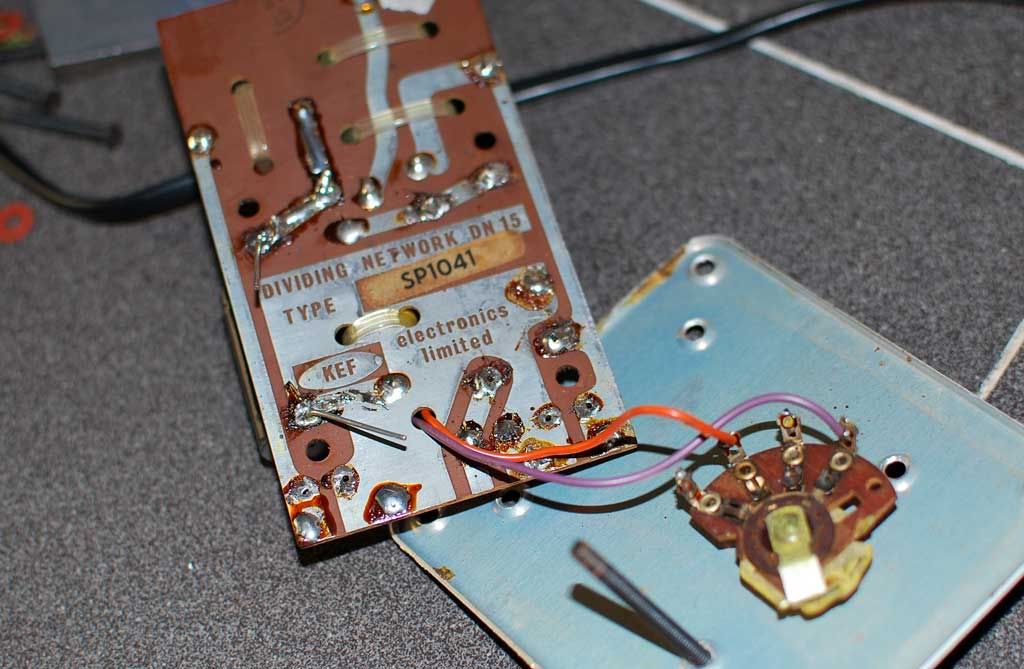
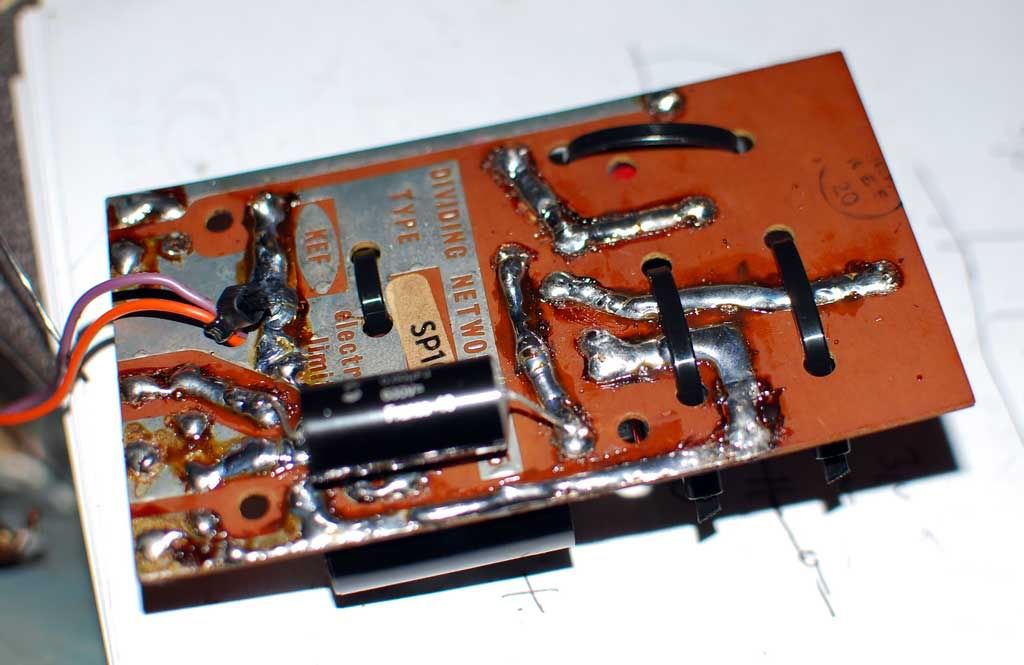
The face plate removal needs care and attention.
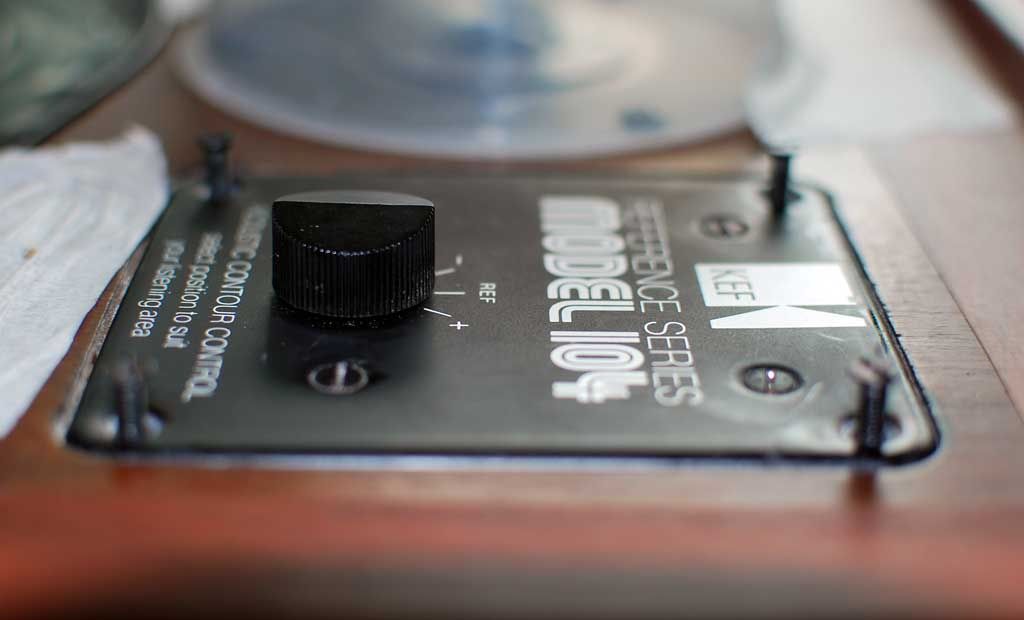
Types of T27A SP1032
There are several batches of T27A, according to the manufactured dates printed on the inner rim of the flange. As long as the measured electrical values are within spec (about 6.5 ohms), there should not be much variations. Anyway, our ears cannot be as accurate as to within +/- 1dB left to right.
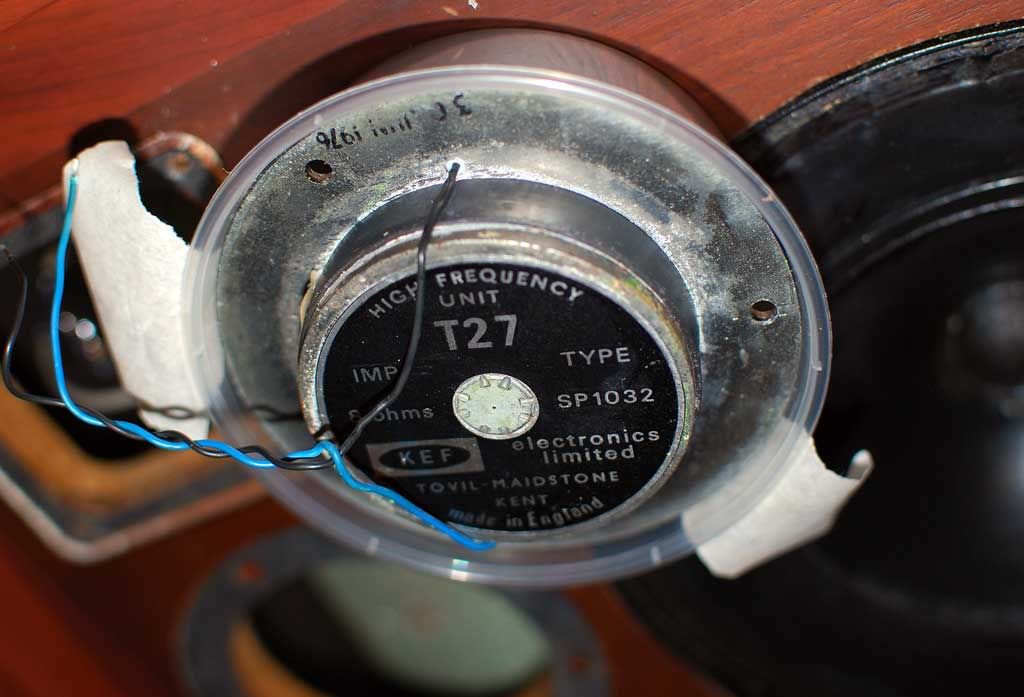
The latter T27A from the constructor series appear different from the T27A produced in the 70s Tovil factory. I am not sure if they came from the same facility.
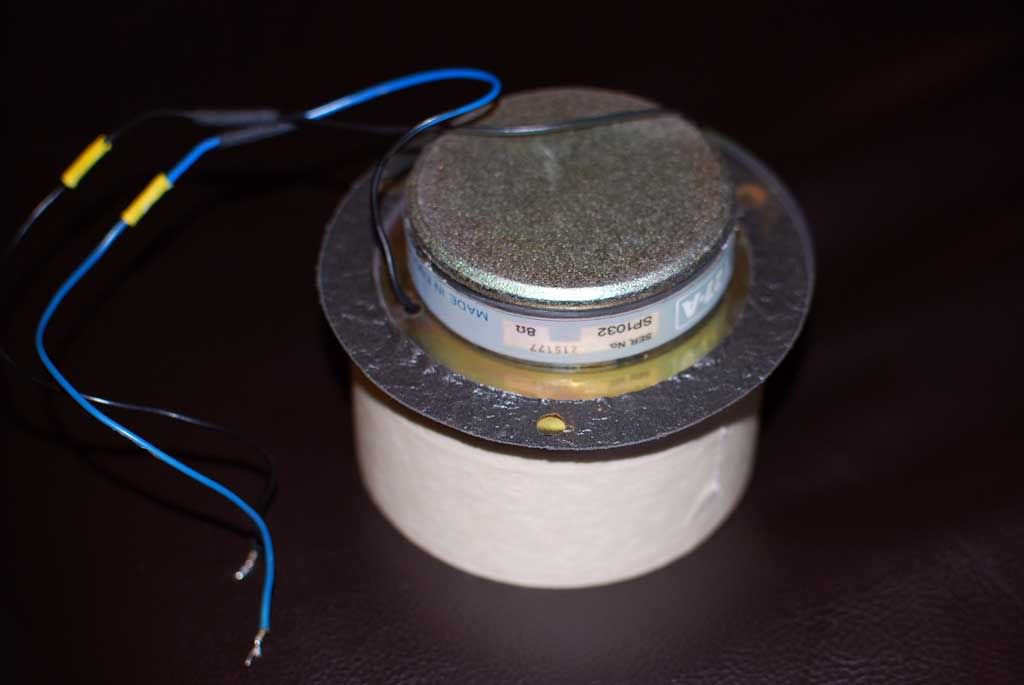
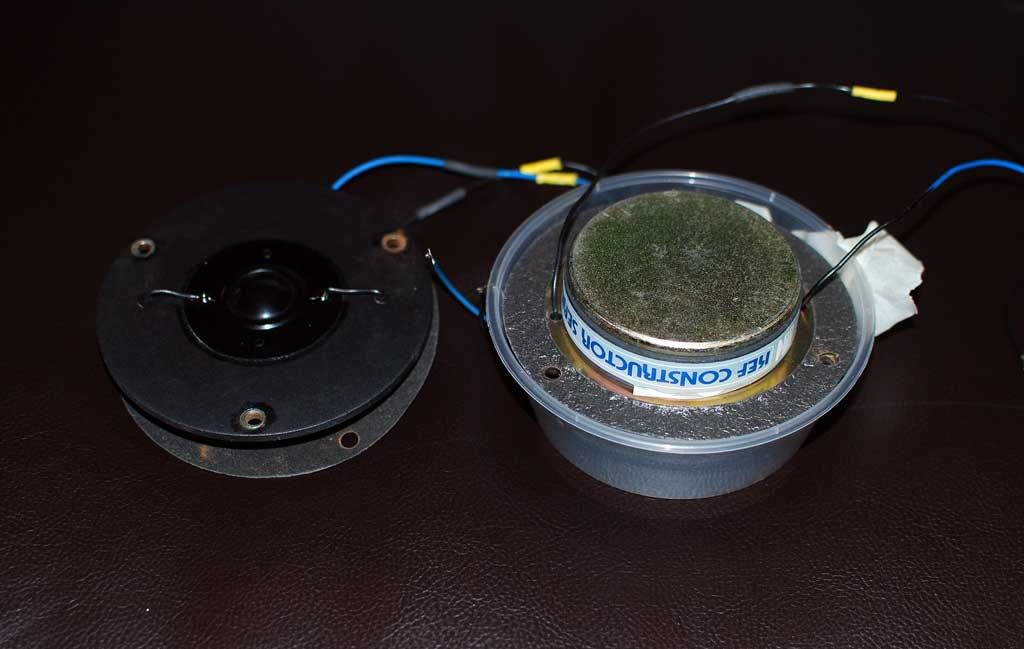
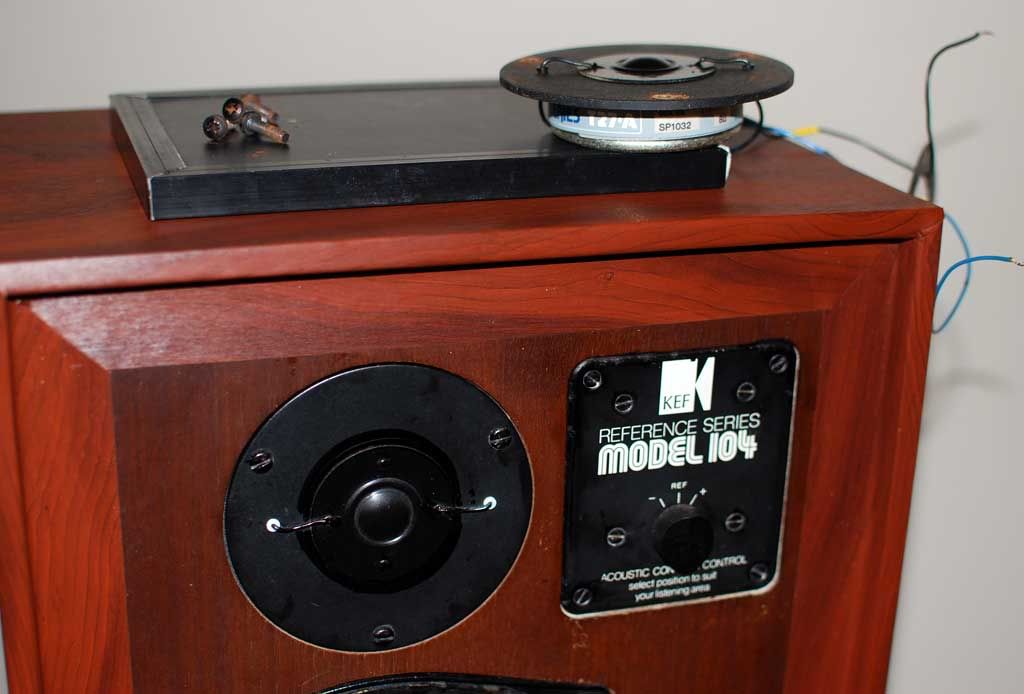
These tweeters appear to exhibit more harshness than the old ones. Perhaps these are more suitable for the aB one crossover. Or the T27A being near 40s years old have become more tamed.
Cabinet
All KEF in the 70s were made with chipboard. When dismantling drivers one has to bear in mind chipboards do not have much mechanical strength and must handle with care.

KEF used sponges to damp the cabinet. By adding modern bitumen sheets we can damp the sides of the cabinet, and allow more air to interact between the B200 SP1054 and the SP1082 passive radiator. The original configuration had the cabinet stuffed with sponge between the passive radiator and the B200.
B200 large magnet
The B200 Sp1054 on my 1973 speaker has a rather strange rubber suspension. It looks almost flat. I consulted several old KEF speaker repairmen whether this was a 'special' done in one of the repair. But the feedback from one old KEF retailer in US told me the rubber would 'flat out' after a long time.
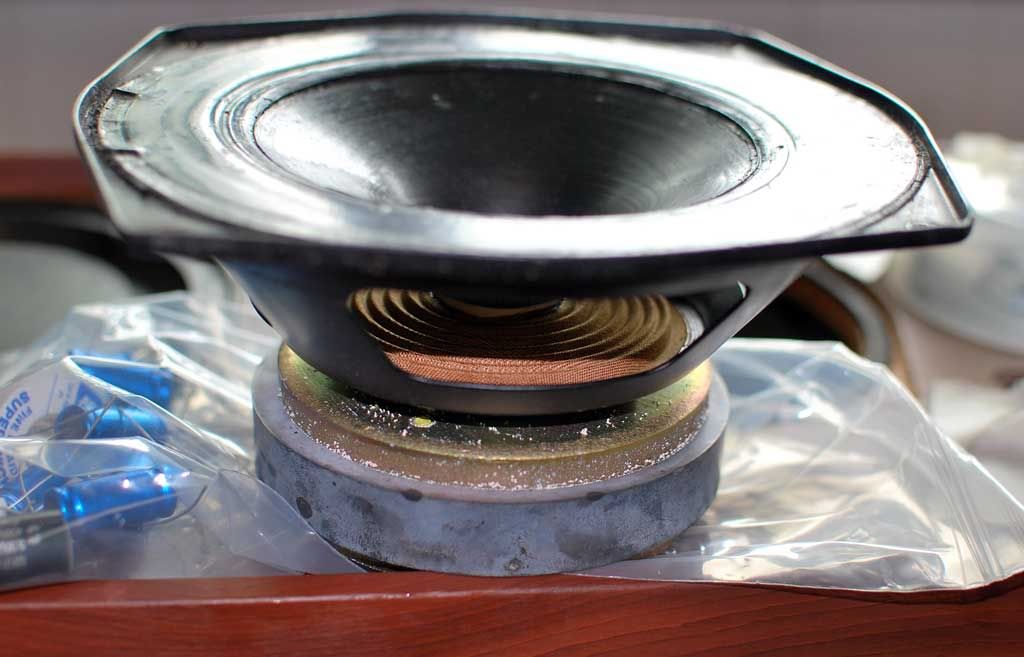
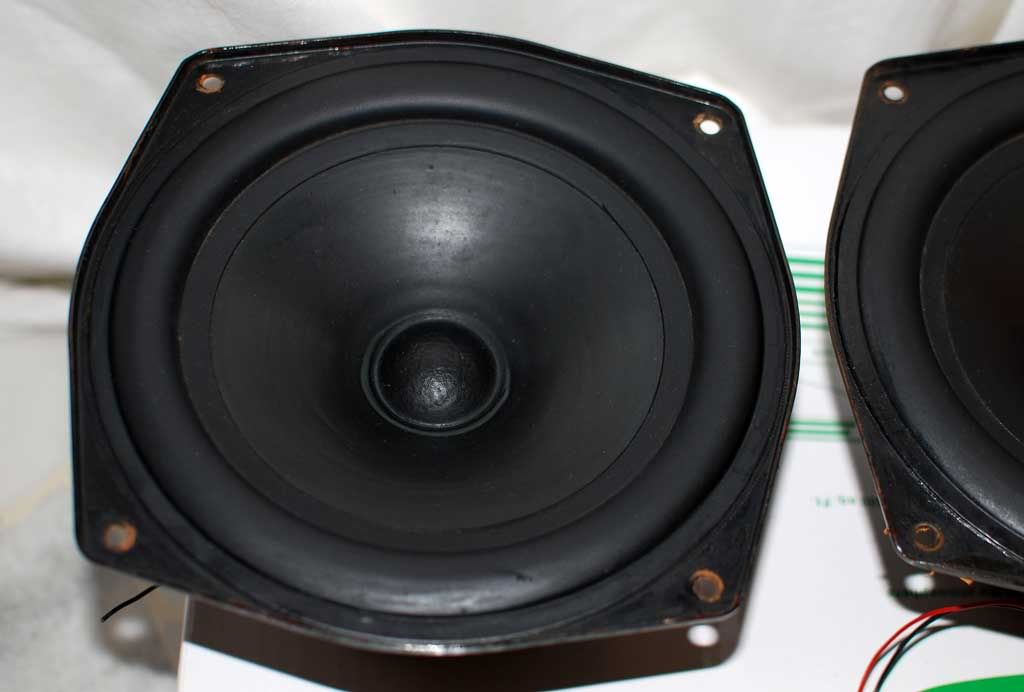
Test Music
Music for an enjoyable evening.
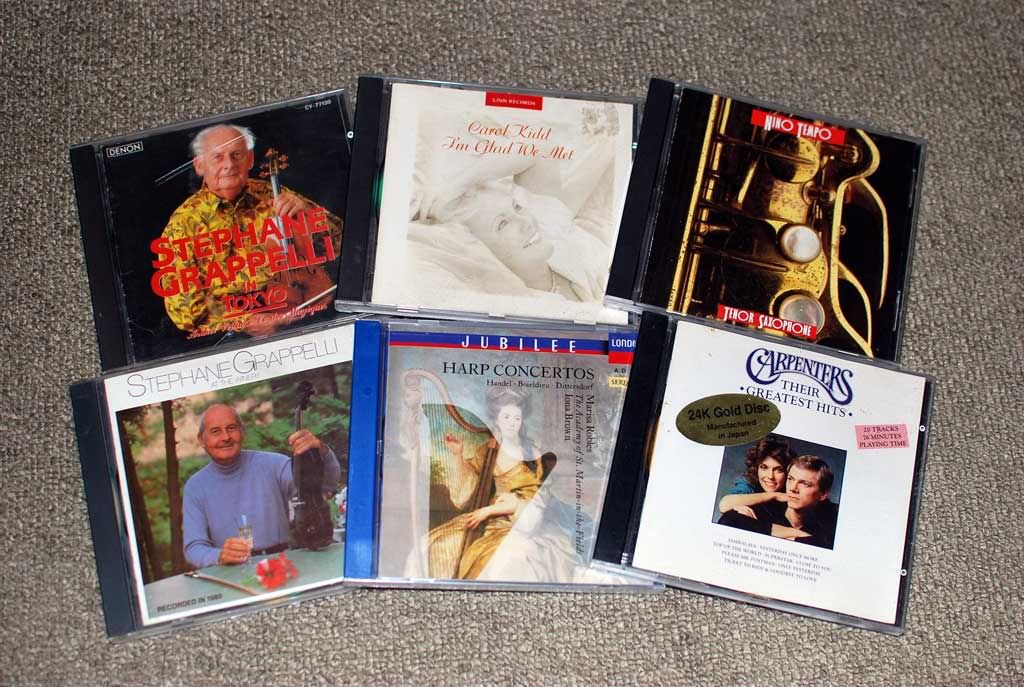
Music for destroying the tweeters. Even the 105.2 would beg for mercy.

Conclusion
The crossover is an integral part of the loud speaker. The capacitor type/value has to be tuned by repeated listening tests.
Expensive capacitor does not guarantee good sound.
The Carli Mylar caps work very well in the KEF 104, if you are after a very smooth and yet detailed sound.
The KEF104 is still an excellent by today’s standards.  |
|
| Back to top |
|
 |
proffski
Über Contributor 1000+

Joined: 22 Aug 2003
Posts: 1297
Location: Tewkesbury UK
|
 Posted: Mon Feb 21, 2011 9:23 pm Post subject: Posted: Mon Feb 21, 2011 9:23 pm Post subject: |
 |
|
Your ears would love you a whole lot more if you changed the HF section to the 104 Ab configuration.
Nice pics! 
_________________
I contend that for a nation to try to tax itself into prosperity is like a
man standing in a bucket and trying to lift himself up by the handle.
-Winston Churchill |
|
| Back to top |
|
 |
Nimo_jon
Intermediate Contributor 25+

Joined: 21 Feb 2011
Posts: 48
Location: Singapore
|
 Posted: Tue Feb 22, 2011 3:22 am Post subject: Posted: Tue Feb 22, 2011 3:22 am Post subject: |
 |
|
Hi and thank you  . .
Yes indeed, I am still working on the 104aB cross over.
I would keep two versions so I can make comparison if need to.
The 104aB cabinet is falling apart and needs extensive wood working. Looks pretty horrid at the moment, but the 104 went thru the same restoration in 2004. I did not put in that much effort then.

104 restored

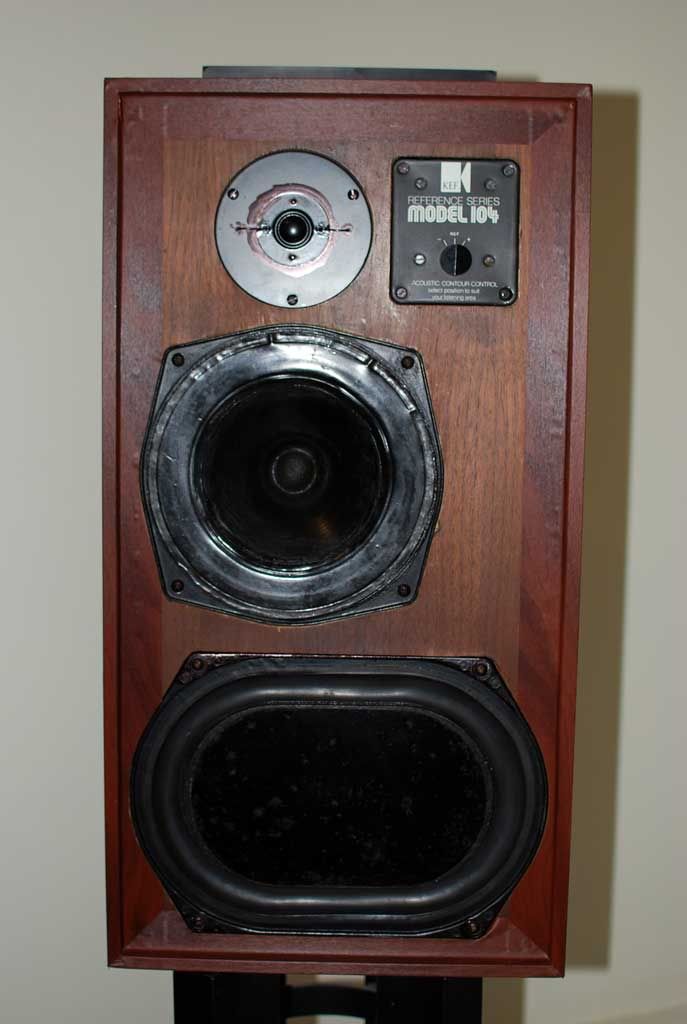 |
|
| Back to top |
|
 |
Richie
Senior Contributor 100+

Joined: 06 Nov 2010
Posts: 108
Location: Northamptonshire
|
 Posted: Tue Feb 22, 2011 10:46 am Post subject: Posted: Tue Feb 22, 2011 10:46 am Post subject: |
 |
|
Great pics and good info, thanks.
Are you saying remove the internal sponges ?
Also, you say "Using Solen sounded lean relative to the Alcap, and more boring" could you expand on this a little ? I was about to replace my Alcaps with Solens but not sure now..... if the Solens sound less bright (boring) than maybe thats for me.
_________________
Still learning ...... |
|
| Back to top |
|
 |
Nimo_jon
Intermediate Contributor 25+

Joined: 21 Feb 2011
Posts: 48
Location: Singapore
|
 Posted: Wed Feb 23, 2011 5:14 am Post subject: Posted: Wed Feb 23, 2011 5:14 am Post subject: |
 |
|
Hi Richie
Thanks. I had to remove the internal sponge because some were turning into power.  The speaker sounded more open and dynamic after this change. The speaker sounded more open and dynamic after this change.
I was hoping the Solen caps would give me a rich, detailed sound. Changing just the 4.2uF position already made the speaker sounded dull and, if some would put it, less bright. So if you can do just this to check it out. 
I am thinking about replacing the rotary switch on the face plate to a multiple pole selector. In that case, I can switch in and out, To aB or not to aB, so to speak. I can mount two crossover net works inside the speaker cabinet, at the space by the side of the B200 driver. If you want less trouble, perhaps you can switch in and out the coupling caps to try it out. I usually use only 2.7mH for the B200, so I can afford to do this. |
|
| Back to top |
|
 |
audiolabtower
VIP Contributor 500+
Joined: 06 Jan 2009
Posts: 686
|
 Posted: Thu Feb 24, 2011 1:31 pm Post subject: Posted: Thu Feb 24, 2011 1:31 pm Post subject: |
 |
|
unfortunately those surrounds have flattened and will have changed the behaviour of the driver 
The 104 might sound better at low level because the original crossover is brighter, so more detail will be apparent when quiet. However the aB is better balanced so will give more depth and wider freq detail around crossover at normal and louder levels, and this is what you have found 
Many years ago I replaced all the caps in my 105s. Many were far from the printed value, but all were matched to better than 1% between channels, thus this was deliberate. This is because Kef selected caps into 1% bands by measurement, and then used high and low values to balance each set of drivers to give the computer predicted flat response and channel matching. Thus the design or actual value leaving the factory may be some way off from the printed value on the capacitor. The inductors were wound to suit the capacitors on the reference series.
I used polyprops and polyesters, and these have much less internal resistance than reversible electrolytics so need low value resistors added to the circuit to compensate for the different dissipation factor, otherwise the sound will be unbalanced. So I measured and replaced the caps to better than 0.25% tolerance to the originals and added 0.5 to 0.8 ohm resistors to compensate.
These are some of the problems associated with swapping elcaps nowadays on speakers so carefully designed in the first place. Unfortunately the original elcaps may have drifted by now so measuring them at 30 or 40 years old may not give the correct design value either 
So when people swap with "audiophile caps" of the same printed value it is no wonder they sound different because in the great majority of cases the frequency response will change and have an freq peak or trough caused by a not quite right value, or a different freq response due to a difference in circuit damping.
I wish we had the crossover/driver records that Kef kept on computer for our reference speakers when they built them.... that would be  |
|
| Back to top |
|
 |
Nimo_jon
Intermediate Contributor 25+

Joined: 21 Feb 2011
Posts: 48
Location: Singapore
|
 Posted: Thu Feb 24, 2011 3:24 pm Post subject: Posted: Thu Feb 24, 2011 3:24 pm Post subject: |
 |
|
Yes indeed, what we have here is a special case of a very old pair of KEF 104 that survived journeys over the world in 40 years. The T27A were changed twice.
The B200s are due for replacement. I for years thought they were special concoction of low compliance suspensions. Well the sound is pretty transparent, I wonder if I want to change it  . .
With regards to cap ESR, I believe KEF designed the crossover based on the curve as shown in pink, in the linear region.
Low ESR is not a bad thing, but it should be constant and not varying with F (linearly or non linearly).
From the chart, the critical F range where Z approaches a short circuit, is certainly not desirable.
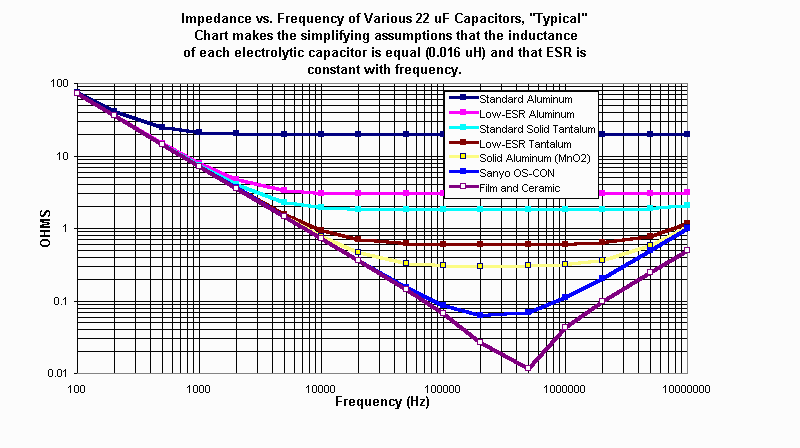
This may explain why many T27A were slain in the field (especially after many replaced the cap with polypropylene type and drove the speakers hard. ) T27A are now easily US$200 a pair, if any, condition regardless.
Falcon cautions: DO NOT use polypropylene throughout in the HF section.
I introduced some old wires from Western Electric tinned copper clothed wire that posed certain R and L. That adds some series resistance you mentioned.
At the end of the day, it is still the beautiful music we want. I am not too concerned about the exact technical specs of the parts. These are antique speakers; if parts are still within 10% or even 20% from spec then its great. I would rather enjoy the music.
I have a lot of respect for every KEF engineer. In the 60s/70s computing power was pathetic. But it seems great stuff were designed/made in the eras where intensive manual calculations were involved. There are tonnes of great tweeters/woofers designed and manufactured these days by CAD/CAM, but which one may be a good replacement for the T27A/B110/B200?  so the KEF were build like musical instruments, not mere transducers. so the KEF were build like musical instruments, not mere transducers. |
|
| Back to top |
|
 |
proffski
Über Contributor 1000+

Joined: 22 Aug 2003
Posts: 1297
Location: Tewkesbury UK
|
 Posted: Thu Feb 24, 2011 3:42 pm Post subject: Posted: Thu Feb 24, 2011 3:42 pm Post subject: |
 |
|
Some good valid points.
I have always been cautious of C/O improvements, does it really sound better or just different? After all after spending megabucks on super capacitors the size of beer cans one automatically expects an “improvement”.
That is not often the case.
Another thing that perplexes me is the removal of internal damping from loudspeakers as a ‘tweak’. Surely the manufacturers would have saved some money by omitting this in the first place and a bit of an insult to the engineers who went through hard work at university to get their qualifications.
The graph is a fine example why sometimes a little knowledge can be more damaging than none!
_________________
I contend that for a nation to try to tax itself into prosperity is like a
man standing in a bucket and trying to lift himself up by the handle.
-Winston Churchill |
|
| Back to top |
|
 |
audiolabtower
VIP Contributor 500+
Joined: 06 Jan 2009
Posts: 686
|
 Posted: Thu Feb 24, 2011 10:14 pm Post subject: Posted: Thu Feb 24, 2011 10:14 pm Post subject: |
 |
|
assuming D.F. is 10%, ie d = 0.1
at 2.5 kHz 7uF series; resistance = 0.9 ohm
at 2.5 kHz 3.3uF series; resistance = 1.9 ohm
however Kef used low loss in the Reference series, certainly for critical series cap for tweeter, probably selected so
assuming D.F. is 5%, ie d = 0.05
at 2.5 kHz 7uF series; resistance = 0.45 ohm
at 2.5 kHz 3.3uF series; resistance = 1.0 ohm probably better
these are maybe more realistic values?
Two identical value series tweeter caps were probably selected one high and one low. If these are replaced with shifts the wrong way round it will lower the impedance and brighten the sound, or may even give amplifier effects, depending on the amp, irrespective of what type of cap is substituted.
I totally agree with proffski about damping. A more "alive" sound is probably just cabinet standing wave colouration, or reflected sound coming through the cone - fine if that's what you like...  |
|
| Back to top |
|
 |
Richie
Senior Contributor 100+

Joined: 06 Nov 2010
Posts: 108
Location: Northamptonshire
|
 Posted: Fri Feb 25, 2011 12:24 pm Post subject: Posted: Fri Feb 25, 2011 12:24 pm Post subject: |
 |
|
| Quote: |
I totally agree with proffski about damping. A more "alive" sound is probably just cabinet standing wave colouration, or reflected sound coming through the cone - fine if that's what you like...  |
I think this is a matter of taste, I have heard other people say they prefer the sound when the sponges are removed (not the panel damping material) slighty less bass control but much more depth of bass, seemingly it allows the ABR to work better because there is more air movement.
The downside to experimenting with speaker cabs is everytime we take in/out a driver we loose a little purchase on the screws 
_________________
Still learning ...... |
|
| Back to top |
|
 |
proffski
Über Contributor 1000+

Joined: 22 Aug 2003
Posts: 1297
Location: Tewkesbury UK
|
 Posted: Fri Feb 25, 2011 12:27 pm Post subject: Posted: Fri Feb 25, 2011 12:27 pm Post subject: |
 |
|
| Richie wrote: | | Quote: |
I totally agree with proffski about damping. A more "alive" sound is probably just cabinet standing wave colouration, or reflected sound coming through the cone - fine if that's what you like...  |
I think this is a matter of taste, I have heard other people say they prefer the sound when the sponges are removed (not the panel damping material) slighty less bass control but much more depth of bass, seemingly it allows the ABR to work better because there is more air movement.
The downside to experimenting with speaker cabs is everytime we take in/out a driver we loose a little purchase on the screws  |
Are the cabinets not fitted with T-Nuts & Bolts?
I fitted those for the T27 as well on mine.
Available in different sizes (or were). http://www.wilmslow-audio.co.uk/t-nut--bolt-set-291-p.asp
_________________
I contend that for a nation to try to tax itself into prosperity is like a
man standing in a bucket and trying to lift himself up by the handle.
-Winston Churchill |
|
| Back to top |
|
 |
audiolabtower
VIP Contributor 500+
Joined: 06 Jan 2009
Posts: 686
|
 Posted: Fri Feb 25, 2011 12:31 pm Post subject: Posted: Fri Feb 25, 2011 12:31 pm Post subject: |
 |
|
| proffski beat me to it! I glued the t nuts to the chipboard so they did not fall off inside the cabinet when you put the bolts in. |
|
| Back to top |
|
 |
Richie
Senior Contributor 100+

Joined: 06 Nov 2010
Posts: 108
Location: Northamptonshire
|
 Posted: Fri Feb 25, 2011 12:32 pm Post subject: Posted: Fri Feb 25, 2011 12:32 pm Post subject: |
 |
|
Mine are just screws, maybe I should fit bolts, would this be a captivated nut ?
_________________
Still learning ...... |
|
| Back to top |
|
 |
Richie
Senior Contributor 100+

Joined: 06 Nov 2010
Posts: 108
Location: Northamptonshire
|
 Posted: Fri Feb 25, 2011 12:34 pm Post subject: Posted: Fri Feb 25, 2011 12:34 pm Post subject: |
 |
|
lol I'll put my order in....... thanks
_________________
Still learning ...... |
|
| Back to top |
|
 |
audiolabtower
VIP Contributor 500+
Joined: 06 Jan 2009
Posts: 686
|
 Posted: Fri Feb 25, 2011 12:39 pm Post subject: Posted: Fri Feb 25, 2011 12:39 pm Post subject: |
 |
|
| yes, if you look at the picture the nut has "teeth" that grip the inside of cabinet chipboard. They are fine for a few unscrews but are held by friction. Sometimes if you push the bolt through you can push them out of the chipboard to fall inside the cab. If you screw up once, then take apart and glue the nuts in their place, leave to set they can last for many disassembles. |
|
| Back to top |
|
 |
|
|
You cannot post new topics in this forum
You cannot reply to topics in this forum
You cannot edit your posts in this forum
You cannot delete your posts in this forum
You cannot vote in polls in this forum
|
Powered by phpBB © 2001, 2005 phpBB Group
|



























